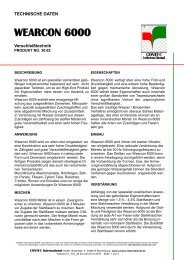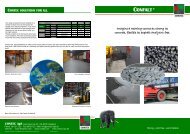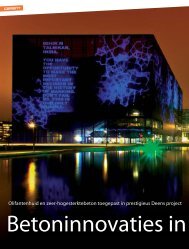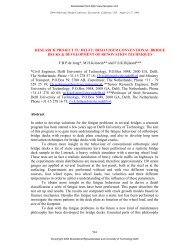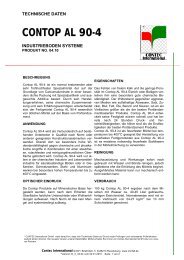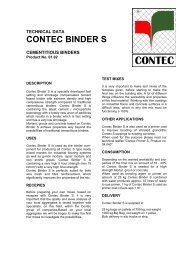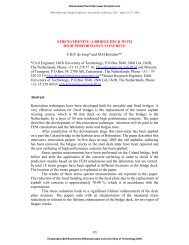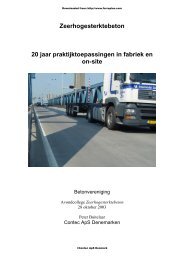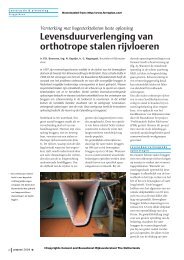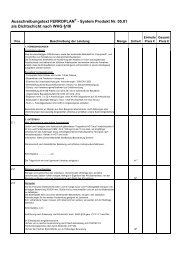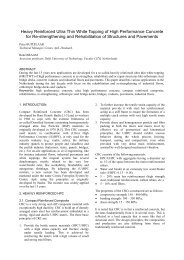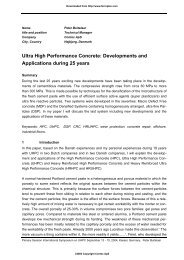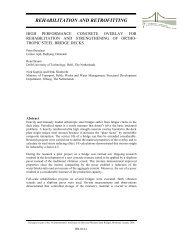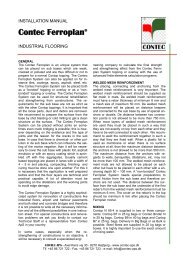Ultra-High-Performance Concrete: Research, Development and ...
Ultra-High-Performance Concrete: Research, Development and ...
Ultra-High-Performance Concrete: Research, Development and ...
Create successful ePaper yourself
Turn your PDF publications into a flip-book with our unique Google optimized e-Paper software.
<strong>Ultra</strong>-<strong>High</strong>-<strong>Performance</strong> <strong>Concrete</strong>:<br />
<strong>Research</strong>, <strong>Development</strong> <strong>and</strong><br />
Application in Europe<br />
Michael Schmidt <strong>and</strong> Ekkehard Fehling<br />
Synopsis: One of the breakthroughs in concrete technology is ultra-high-performance<br />
concrete with a steel like compressive strength of up to 250 N/mm 2 <strong>and</strong> a remarkable<br />
increase in durability compared even with high-performance concrete. In combination<br />
with steel fibres it is now possible to design sustainable filigree, lightweight concrete<br />
constructions with or even without additional reinforcement. Wide span girders, bridges,<br />
shells <strong>and</strong> high rise towers are ideal applications widening the range of concrete<br />
applications by far. In addition e.g. to some pedestrian bridges heavily trafficked road<br />
bridges has been build in France <strong>and</strong> in the Netherl<strong>and</strong>s. Bridges are already under<br />
construction in Germany as well. A wide range of new concrete formulations has been<br />
developed to cover an increasing number of applications. Technical recommendations<br />
have recently been published in France <strong>and</strong> in Germany covering material as well as<br />
design aspects.<br />
The paper will report on the state of research <strong>and</strong> application of UHPC in Europe, on<br />
material <strong>and</strong> design aspects of UHPC <strong>and</strong> will present the state-of-the-art based on an<br />
International Symposium on UHPC held in Kassel in 2004.<br />
Keywords: ultra high performance concrete; raw materials; durability; design aspects
Michael Schmidt<br />
born 1947, studied Civil Engineering 1967-1973 at the Technical University of Hanover<br />
(Germany), received doctoral degree in 1977 from TU Hanover.<br />
<strong>Research</strong> Engineer <strong>and</strong> Senior Specialist at the <strong>Research</strong> Institute of the German Cement<br />
Industry in Düsseldorf 1978-1989. Director of <strong>Research</strong> <strong>and</strong> <strong>Development</strong> of the<br />
HeidelbergCement Group 1989-1998. Since 1998 Independent Public Consultant <strong>and</strong><br />
Court Expert for building materials <strong>and</strong> cement <strong>and</strong> gypsum industry in Germany,<br />
Europe <strong>and</strong> Asia. Since 1999 Professor, head of Building Materials Department <strong>and</strong><br />
Director of Governmental Testing Institute at the University of Kassel.<br />
Ekkehard Fehling<br />
born 1959, studied Civil Engineering 1978 -1983 at the Technical University of<br />
Darmstadt (Germany), received doctoral degree in 1990 from TU Darmstadt.<br />
Since 1988 registered Consulting Engineer, since 1997 State licensed Checking Engineer<br />
<strong>and</strong> Professor of Structural Engineering, University of Kassel,<br />
Partner of IBB Fehling+Jungmann, Consulting Engineers, Kassel / Fulda (Germany)<br />
INTRODUCTION<br />
Within the last two decades amazing progress has been made in concrete technology.<br />
One of the breakthroughs is the development of ultra-high-performance concrete with a<br />
steel like compressive strength of up to 250 N/mm 2 <strong>and</strong> a remarkable increase in<br />
durability compared even with high-performance concrete. In combination with a<br />
sufficiently high amount of steel fibers it is now possible to design sustainable filigree,<br />
lightweight concrete constructions without any additional reinforcement. In prestressed<br />
construction elements the prestressing forces may be increased significantly especially if<br />
high-strength steel is used. Long span girders, bridges <strong>and</strong> shells are ideal applications<br />
widening the range of concrete applications by far. First practical steps into the future of<br />
concrete constructions have already been done. In addition to the well known pedestrian<br />
bridge in Sherbrooke in Canada <strong>and</strong> in South Korea heavily used road bridges has been<br />
build or reconstructed in France <strong>and</strong> in the Netherl<strong>and</strong>s. A long span footbridge is under<br />
construction in Germany <strong>and</strong> the construction of a road bridge used by traffic under<br />
severe climatic conditions with intensive salt attacks in winter will start this year to gain<br />
more practical experiences with the durability of UHPC.<br />
The growing store of knowledge about the material itself <strong>and</strong> about the adequate design<br />
of constructions with UHPC enabled a technical working groups in France to draw up<br />
first technical recommendations primarily focussing on the design (Resplendino 2004,<br />
SETRA-AFGC 2002). In Germany a state-of-the-art report has recently been published<br />
covering all material <strong>and</strong> design aspects (DAfStB UHPC 2003).<br />
That means that the concrete itself is steadily optimized <strong>and</strong> a wide range of new<br />
formulations are developed to cover the individual needs of an increasing number of<br />
different applications. This paper will report on the state of research <strong>and</strong> development on<br />
UHPC in Europe <strong>and</strong> about recent applications either already realized, under<br />
construction or under development.
HISTORY OF DEVELOPMENT AND APPLICATIONS<br />
In the 1960s concretes with an compressive strength of up to 800 N/mm 2 has been<br />
developed <strong>and</strong> produced under specific laboratory conditions. They were compacted<br />
under high pressure <strong>and</strong> thermally treated. In the early 1980s the idea was born to<br />
develop fine grained concretes with a very dense <strong>and</strong> homogeneous cement matrix<br />
preventing the development of microcracks within the structure when being loaded.<br />
Because of the restricted grain size of less than 1 mm <strong>and</strong> of the high packing density<br />
due to the use of different inert or reactive mineral additions they were called “Reactive<br />
Powder <strong>Concrete</strong>s (RPC)” (Bache 1981; Richard <strong>and</strong> Cheyrezy 1995). Meanwhile there<br />
existed a wider range of formulations <strong>and</strong> the term “<strong>Ultra</strong>-<strong>High</strong>-<strong>Performance</strong> <strong>Concrete</strong>”<br />
or – in short – UHPC was established worldwide for concretes with a minimum<br />
compressive strength of 150 N/mm 2 .<br />
The first commercial applications started around 1980, based on the development of so<br />
called D.S.P. mortars in Denmark (Buitelaar 2004). It was primarily used for special<br />
applications in the security industry – like vaults, strong rooms <strong>and</strong> protective defense<br />
constructions.<br />
First research <strong>and</strong> developments aiming at an application of UHPC in constructions<br />
started in about 1985. Since then different technical solutions were developed one after<br />
the other or parallelly: Heavily (conventionally) reinforced UHPC precast elements for<br />
bridge decks; in situ applications for the rehabilitation of deteriorated concrete bridges<br />
<strong>and</strong> industrial floors (Buitelaar 2004) ductile fiber reinforced fine grained “Reactive<br />
Powder <strong>Concrete</strong>” (RPC) like “Ductal” produced by Lafarge in France or Densit<br />
produced in Denmark (Acker <strong>and</strong> Behloul 2004). With or without additional “passive”<br />
reinforcement it is used for precast elements <strong>and</strong> other applications like offshore bucked<br />
foundations. In addition, coarse grained UHPC with artificial or natural high strength<br />
aggregates were developed e.g. for highly loaded columns <strong>and</strong> for extremely high-rise<br />
buildings (Schmidt et al. 2003). Nowadays an increasing range of formulations is<br />
available <strong>and</strong> can be adjusted to meet the specific requirements of an individual design,<br />
construction or architectural approach.<br />
Breakthroughs in application were the very first prestressed hybride pedestrian bridge at<br />
Sherbrooke in Canada in 1997, the replacement of steel parts of the cooling tower at<br />
Cattenom <strong>and</strong> two 20.50 <strong>and</strong> 22.50 m long road bridges used by cars <strong>and</strong> trucks at<br />
Bourg-lès-Valence in France build in 2001 (Hajar et al. 2004), see fig. 1.<br />
For these projects the UHPC was reinforced with about 2.5 to 3 Vol.-% of steel fibers of<br />
different shape. The bridges in Bourg-lès-Valence consists of five precast beams which<br />
are pre-tensioned. They were placed on site <strong>and</strong> then joined together with in-situ UHPC.<br />
Other footbridges with decks <strong>and</strong>/or other load bearing components made of fine<br />
grained, fiber reinforced UHPC exist in Seoul <strong>and</strong> in Japan (Acker <strong>and</strong> Behloul 2004).<br />
A spectacular example of architectural taking advantage of the special benefits of UHPC<br />
is the toll-gate of the Millau Viaduct in France, currently under construction. Fig. 2<br />
shows the elegant roof “looking like an enormous twisted sheet of paper”, 98 m long <strong>and</strong><br />
28 m wide with a maximum thickness of 85 cm at the center (Resplendino 2004). The<br />
structure remembers an aircraft wing. It will be made of match-cast prefabricated 2 m<br />
wide segments connected by an internal longitudinal prestressing.
In other European countries UHPC is gaining increasing interest as well. In Germany, as<br />
a result of an extensive research project financed by the government, technical criteria<br />
<strong>and</strong> measures have been already developed to use regionally available raw materials for<br />
fine or coarse grained UHPC, to reduce the cement content <strong>and</strong> to use fiber mixtures <strong>and</strong><br />
noncorrosive high strength plastic fibers to control the strength <strong>and</strong> the ductility<br />
depending on the requirements given by an individual design <strong>and</strong> construction (Fehling<br />
et al. 2003; Bornemann et al. 2001; Schmidt et al. 2003; Bornemann <strong>and</strong> Faber 2004).<br />
As a first application, a hybrid bridge is under construction (Fehling et al. 2004) for<br />
pedestrian <strong>and</strong> bicycles with a length of about 135 m <strong>and</strong> a maximum span of 40 m<br />
consisting of precast prestessed chords <strong>and</strong> precast bridge deck elements made of UHPC<br />
with a maximum grain size of 2 mm using local materials. Fig. 3 shows an animation of<br />
the bridge, fig. 4 its cross section. The 4.50 x 2.00 x 0.08 m wide bridge deck elements<br />
are prestessed transversely. As an additional step of innovation, the load bearing UHPCelements<br />
are glued together without any additional mechanical connection. This means a<br />
further step towards an economic material adequate construction technique for UHPC.<br />
Inspired by first applications in Canada, South Korea <strong>and</strong> Europe <strong>and</strong> by intensive<br />
research <strong>and</strong> development efforts at different universities <strong>and</strong> of the cement- <strong>and</strong><br />
construction industry, the DAfStB draw up a state-of-the-art-report on <strong>Ultra</strong>-<strong>High</strong>-<br />
<strong>Performance</strong> <strong>Concrete</strong> (DAfStB UHPC 2003). The DAfStB is part of the German<br />
St<strong>and</strong>ardization Organization DIN being responsible for all st<strong>and</strong>ards <strong>and</strong> technical<br />
requirements related to the production <strong>and</strong> application of concrete <strong>and</strong> giving the rules<br />
for the design of concrete structures.<br />
The German state-of-the-art-report covers the technical know-how <strong>and</strong> the experience<br />
with UHPC worldwide published. It covers nearly all applications that exist hitherto –<br />
primarily based on commercially available UHPC mixtures – the main principles <strong>and</strong> the<br />
characteristic behavior criteria, durability aspects <strong>and</strong> the resistance against fire. A<br />
second part report refers to the adequate design <strong>and</strong> construction of structures using<br />
UHPC. The report traditionally is a first step towards a reliable technical guideline <strong>and</strong> a<br />
latter st<strong>and</strong>ard for UHPC.<br />
In the following some of the material <strong>and</strong> design aspects covered by the German stateof-the-art-report<br />
<strong>and</strong> by the French design recommendations are presented in more<br />
detail.<br />
Raw materials <strong>and</strong> material structure<br />
MATERIALS<br />
Both the high compressive strength <strong>and</strong> the improved durability of UHPC are based<br />
upon the same four principles<br />
- a very low water-cement-ratio of about 0.20 to 0.25 resulting in a very dense <strong>and</strong><br />
strong structure of the hydration products <strong>and</strong> minimizing the capillary pores, which<br />
are ductile to prevent brittle failure <strong>and</strong> to be able to use more or less traditional<br />
design approaches against the transport of harmful gases <strong>and</strong> liquids into <strong>and</strong><br />
through the concrete,
- a high packing density especially of the fine grains in the binder matrix reducing the<br />
water dem<strong>and</strong> of the fresh mix <strong>and</strong> increasing the compressive strength – as well as<br />
the brittleness of the concrete,<br />
- the use of higher amounts of effective superplastizisers to adjust the workability <strong>and</strong><br />
– if needed –<br />
- the use of steel or other fibers to increase the tension, the bending tension <strong>and</strong> the<br />
shear strength <strong>and</strong> to make the concrete sufficiently ductile.<br />
Fig. 5 shows the packing effect schematically. As a simplified example, fig. 6 shows<br />
how the packing density develops when two quartz powders of different fineness (Q 1<br />
<strong>and</strong> Q 2) are mixed together in different amounts (Geisenhanslüke <strong>and</strong> Schmidt 2004a).<br />
Up to a ratio of about 30 % of the fine <strong>and</strong> 70% of the “coarse” powder the packing<br />
density – defined by the part by volume of particles per unit volume - increases from 48<br />
to 54 Vol.-%. The finer particles by <strong>and</strong> by fill up the hollow space in between the<br />
coarser grains. At the same time, the viscosity of a lime prepared with the powder-mixes<br />
at a constant water/fines-ratio of 0.26 decreased from 7500 to less than 5000 mPa s. If<br />
the amount of fine particles is further increased beyond the maximum packing density,<br />
the rheology of the mix becomes suboptimal again.<br />
To optimize the packing density of UHPC, usually specified quartz powders are used.<br />
Table 1 shows typical compositions of fine <strong>and</strong> course grained UHPC developed <strong>and</strong><br />
used in Germany, fig. 7 the optimized grain size distribution of mix M1Q in table 1<br />
consisting of four different fines. The correlation between the packing density –<br />
characterized by the water/fines-ratio of the matrix w/Fv – <strong>and</strong> the compressive strength<br />
of heat treated (90°C) <strong>and</strong> water cured Cylinders (150/300 mm) is shown in fig.8. It is<br />
obvious that the packing density not only affects the rheology but also the strength of<br />
UHPC as well: at nearly the same water-cement ratio of 0.20 the compressive strength<br />
increased by about 25 % when the w/Fv-value decreased from 0.53 to 0.40 by adding an<br />
pre-calculated amount of another quartz filler with a specified fineness. And table 1 a<br />
fig. 8 show that the use of coarser grains help to reduce the cement content <strong>and</strong><br />
contributes to the compressive strength as well. Further tests showed that autogenous<br />
shrinkage <strong>and</strong> creeping were significantly reduced. The effectiveness of the fibers was<br />
reduced as well. This disadvantage could be partly compensated for using longer <strong>and</strong><br />
stiffer fibers with a length of 17 mm <strong>and</strong> a diameter of 0.25 mm (Bornemann <strong>and</strong> Faber<br />
2004).<br />
Due to an European Directive, quartz fillers containing particles with a diameter of less<br />
than 5 micron are suspected to cause health problems. This led to intensive efforts to<br />
replace those particles by other mineral powders. Positive experiences have been gained<br />
with finely ground granulated blast furnace slag, the fine <strong>and</strong> glassy parts of ground or<br />
assorted fly ashes from stone coal power plants <strong>and</strong> with some high quality stone dusts<br />
e.g. produced from basalt. <strong>Ultra</strong> fine slag particles are even adequate to partly replace<br />
microsilica. Common limestone fillers are – as a rule – less beneficial. <strong>Research</strong> is done<br />
to further improve the rheological <strong>and</strong> the strength performance of UHPC by adding<br />
nanotubes (Kowald 2004).<br />
The optimization process can be based on both a theoretical <strong>and</strong> experimental<br />
approaches. Usually the procedure of Okamura (Okamura 1995) is used. In Germany the<br />
actual packing density of cements or other powders is tested using the fast <strong>and</strong> easy<br />
Puntke-test (Puntke 2002). A specimen of about 100 g of the powder is filled into a<br />
container <strong>and</strong> slightly compacted. Than water or – for tests on powder mixes containing
cement - a non-reactive liquid of known density is added until the surface is just wet.<br />
The amount of liquid added is a measure for the hollow space <strong>and</strong> – indirectly – for the<br />
packing density.<br />
Testing is time consuming <strong>and</strong> expensive, especially if the existing information about the<br />
powders is lacking <strong>and</strong> the grain size optimization needs several steps of iteration.<br />
Therefore some mathematically based, computer aided calculation procedures have been<br />
developed to pre-calculate the best fitting powders <strong>and</strong> the amounts of each being<br />
adequate to reach a maximum packing density (Geisenhanslüke <strong>and</strong> Schmidt 2004a).<br />
Experiences have shown that the results of the existing calculation procedures do not<br />
reflect sufficiently the reality when powders of different grain size, grain size<br />
distribution, shape <strong>and</strong> roughness of the surface are mixed in different proportions. In an<br />
active research project these procedures are developed further considering the 3dimensionality<br />
of the structure, the shape, the friction of the grains <strong>and</strong> the so called<br />
“particle h<strong>and</strong>icap” schematically shown in figure 9. These effects hinder the individual<br />
grains to really reach their theoretical optimum position within the structure of the<br />
powder mix.<br />
Strength <strong>and</strong> deformation behavior<br />
Basis of an adequate, economic <strong>and</strong> safe design of structures fully or even partly<br />
consisting of UHPC elements are reliable reference values characterizing the strength<br />
<strong>and</strong> the deformation behavior under static <strong>and</strong> dynamic loads. Fiber free fine or coarsely<br />
grained UHPC mixtures as shown in table 1 are characterized by both, a high<br />
compressive strength in between 150 <strong>and</strong> 250 N/mm 2 primarily depending on the watercement<br />
ratio, the volumetric water-to-fines ratio w/Fv = w/Σ Vol.(cement+silica+fillers)<br />
of the matrix <strong>and</strong> the grain size of the aggregates as well as a linear elastic deformation<br />
up to about 95% of the fracture load. That means UHPC without fibers is a glass like<br />
brittle material with a comparatively high modulus of elasticity of 50.000 to 70.000<br />
N/mm 2 . The typical tension strength of the pure matrix is about 8 N/mm 2 .<br />
Using steel or other adequate fibers with a sufficiently high modulus of elasticity of<br />
more than about 45.000 N/mm 2 , the compressive strength keeps constant or increases<br />
slightly while the tension, the bending tension <strong>and</strong> the shear strength as well as the<br />
ductility are significantly improved. As an example, table 2 (Bornemann et al. 2001;<br />
Fehling <strong>and</strong> Bunje 2004) shows that the bending tension strength of concrete prisms<br />
40/40/160 mm made of fine grained UHPC (Mix M1Q) with 2.5 Vol-% of short steel<br />
fibers (length 6 to 9 mm, diameter 0.15 mm) was up to 36 N/mm 2 , that of beams<br />
150/150/700 mm made from the same concrete but without steel fibers was 22 N/mm 2<br />
only.<br />
That means if the bending strength of fibered UHPC is introduced into the design of<br />
structures it has to be considered that the bending strength primarily depends on the kind<br />
<strong>and</strong> the amount of fibers used, but the orientation <strong>and</strong> the distribution of the fibers within<br />
the matrix <strong>and</strong> the shape of the specimen used <strong>and</strong> of the structural element produced<br />
with the specific concrete may have a significant influence as well. As a rule, the spread<br />
of test results of a specific mixture exceeds that of UHPC mixtures without fibers<br />
significantly. Therefore the number of tests done to characterize one specific mix has to<br />
be increased to allow a calculation based on the st<strong>and</strong>ard deviation („Characteristic<br />
Strength“, 5% fractile). In some active research projects these aspects are further
investigated. Until sufficient knowledge has been gathered <strong>and</strong> measures have been<br />
developed in order to influence e.g. the fiber orientation by the production process,<br />
elements of the designed shape should be placed <strong>and</strong> tested to validate the theoretically<br />
assumed design criteria.<br />
The same aspects have to be considered regarding the ductility of UHPC. The “amount”<br />
of ductility being necessary to fit the needs depends on the individual design <strong>and</strong><br />
construction approach: if the UHPC is assigned for bearing the full tension <strong>and</strong> bending<br />
tension loads without any additional active or passive reinforcement – like in some of the<br />
applications e.g. of Ductal – the fiber content has to be sufficiently high to prevent<br />
sudden failure even if cracks due to uncalculating stresses <strong>and</strong> strains appearing locally .<br />
In those cases a fiber content of about 2.5 to 3 Vol.-% may give a satisfying compromise<br />
regarding workability of the fresh concrete, bending strength <strong>and</strong> ductility. For other<br />
applications, a reduced amount of e.g. 1 Vol.-% of fibers may satisfy the needs, e.g. if<br />
slabs, girders or other elements made from UHPC are fully pre-stressed <strong>and</strong>/or have a<br />
passive reinforcement. The fibers are some kind of “transportation reinforcement” <strong>and</strong>/or<br />
allow to utilize the high compressive strength more efficiently due to a higher safety<br />
margin to failure. As explained later a combination of passive reinforcement <strong>and</strong> fibers<br />
allow the shear reinforcement of beams to be omitted under bending loads. And in some<br />
cases UHPC may be applied even without fibers, e.g. for highly loaded columns or<br />
framework constructions consisting of ductile steel pipes filled with UHPC (Tue,<br />
Schneider, <strong>and</strong> Schenk 2004).<br />
In Fig. 10 the effectiveness of steel fibers, high strength non-corrosive Polyvinyl fibers<br />
<strong>and</strong> a mixture of both, a so called “fiber cocktail” is shown (Bornemann <strong>and</strong> Faber<br />
2004). Mixes consisting of steel <strong>and</strong> other suitable fibers of different kind, length <strong>and</strong><br />
diameter may fulfill the individual needs of a construction more effective by <strong>and</strong> more<br />
economically than fibers of one uniform type.<br />
Durability<br />
The improved resistance of UHPC to all kinds of harmful gases <strong>and</strong> liquids, to chloride<br />
<strong>and</strong> frost or freezing <strong>and</strong> thawing attacks is related to the improved density both of the<br />
grain structure of the matrix <strong>and</strong> the much denser contact zone between the matrix <strong>and</strong><br />
the (coarser) aggregates as well as by the denser structure of the hydration products. Fig.<br />
11 gives an impression of the dense structure.<br />
The porosity of UHPC is characterized by the absence of capillary pores, as one can see<br />
from the pore size distribution shown in fig. 12 tested by mercury intrusion. As a result,<br />
the extremely high resistance e.g. to chloride diffusion is shown in fig. 13. The resistance<br />
to attacks by freezing <strong>and</strong> salting are significantly improved even when compared with<br />
<strong>High</strong> <strong>Performance</strong> <strong>Concrete</strong>, see fig. 14.<br />
In table 3 some characteristic durability indicators are given based on different sources<br />
(Schmidt et al. 2003, Teichmann <strong>and</strong> Schmidt 2004; Resplendino 2004;)
DESIGN ASPECTS<br />
As a rule, the design of concrete structures has to be based on reliable but simplified<br />
material reference values, e.g. for the strength <strong>and</strong> the deformation behavior. For<br />
ordinary concrete those approaches are given in the relevant st<strong>and</strong>ards. For UHPC two<br />
similar approaches have been developed, one established by AFGC/SETRA in France in<br />
2002 (SETRA-AFCG 2002) <strong>and</strong> one as part of the state-of-the-art report of the DAfStB<br />
in Germany in 2003 (DAfStB UHPC 2003). They both consider the fact, that as a rule<br />
the material properties of fiber reinforced UHPC show a significant higher deviation due<br />
to an inhomogenious distibution <strong>and</strong> orientation of the fibres in the matrix (Bernier <strong>and</strong><br />
Behloul 1996).<br />
The French recommendations consist of three parts:<br />
– the first part gives specifications on the mechanical performance to be obtained <strong>and</strong><br />
recommendations for characterizing UHPC including checks of finished products <strong>and</strong><br />
of the concrete being produced,<br />
– the second part deals with the design <strong>and</strong> analysis of structures made with fibre<br />
reinforced, non-prestressed <strong>and</strong>/or non-reinforced UHPC-elements <strong>and</strong><br />
– a third part dealing with the durability of UHPC.<br />
An important part deals with the behavior of fiber containing UHPC under tensile<br />
loading. As fig. 15 (Resplendino 2004; SETRA-AFCG) shows, the stress-strain relation<br />
is characterized by an elastic stage limited by the tensile strength of the cement matrix ftj<br />
<strong>and</strong> a post cracking stage characterized by the tensile strength of the composite material<br />
reached by fiber action.<br />
Using characterization tests depending on the type of structure studied (thin or thick<br />
slabs, beams, shells) <strong>and</strong> on the kind of load (direct or flexural tensile) the<br />
recommendations give the transfer factors to come from the test results to an “intrinsic”<br />
curve for tensile behavior independent of the size of the specimen <strong>and</strong> the kind of test<br />
used. In addition, a reduction factor is given to take into account the effect placement<br />
methods has on the real strength values to be obtained in a specific structural element.<br />
The French design methods proposed are in accordance with the French codes for prestressed<br />
or reinforced concrete BAEL 91 <strong>and</strong> BPEL 91 based on semi-probabilistic limit<br />
state values. Supplementary to the design codes the recommendations contain<br />
specificities concerning UHPC like the strength provided by fibers which allows the<br />
design of structures without any conventional reinforcement.<br />
For normal stress verification, the French recommendations use the AFREM-BFM<br />
method which concerns fiber concrete, <strong>and</strong> use a stress-crack width constitutive law σ =<br />
f(w). Moreover the characteristic length lc is introduced, to go from crack width w to<br />
strain ε:<br />
ε = ftj / Eij + w/ Ic,<br />
The value of Ic depends on the sections area. The analysis for st<strong>and</strong>ard sections is based<br />
on the assumptions that plane sections remain plane <strong>and</strong> the concrete behavior law<br />
follows fig. 16. The limit stresses at the SLS are the same as for a reinforced or
prestressed structure: 0.3 mm for normal cracking, 0.2 mm for detrimental <strong>and</strong> 0.1 mm<br />
for highly detrimental cracking.<br />
For calculation of the Serviceability Limit State (SLS), a somewhat more simplified<br />
stress strain relationship as shown in Fig. 17 may be used according to the<br />
recommendations given by (DAfStb UHPC 2003).<br />
The German report describes a st<strong>and</strong>ard test procedure as shown in fig. 18 to evaluate<br />
the load-deformation behavior of UHPC under bending loads in order to determine a<br />
stress strain relationship.<br />
Fig. 19 shows the result of such a test. To transform it into a stress-strain relation, the<br />
stresses at a crack width of 0.5 <strong>and</strong> 3.5 mm are being considered.<br />
Fig. 20 shows the stress-strain curves calculated according to this proposal. The stresses<br />
at the significant points of the curve are determined from the equations<br />
σ2.0 – 3.5 ‰ = f ctk0.5 • 0.37<br />
σ25‰ = β ٠f ctk3,5.<br />
The factor β as well as the factor 0.37 have been established by recalculating test results.<br />
As for ordinary concrete, the factor β depends on the relation fctk,3.5 / f ctk,0.5. It can be<br />
taken from fig. 21.<br />
Normally a strain limit of 25‰ is adequate. But re-calculations of test results already<br />
showed that for a ratio f3.5 / f0.5 < 0,5 the design may fall short of the necessary safety<br />
margin. In fig. 21 the reduced strain for f3.5/f0.5 < - 0.5 is characterized by the marked<br />
curve.<br />
For the design in the Ultimate Limit State, the stress strain law according to DIN 1045-1<br />
is proposed. It is defined by the following equation (1):<br />
n<br />
⎡ ⎛ ε ⎞ ⎤<br />
c ⎢ ⎜ ⎟ ⎥<br />
⎢ ⎝ εc2<br />
⎠ ⎥<br />
σ c =−fcd ⋅ 1− 1−<br />
⎣ ⎦<br />
ε c2 strain at maximum stress<br />
ε c2u ultimate strain for design purposes<br />
for 0 ≥εc ≥ε c2<br />
(1)<br />
The exponent n in Eq. 1 can be taken from table 4. This enables a transition to the rules<br />
for <strong>High</strong> Strength <strong>Concrete</strong> (HSC/HPC). For UHPC 210 <strong>and</strong> higher strength classes,<br />
hence, a linear relationship results. Furthermore, for UHPC without fibers or insufficient<br />
confinement,εc2 = εc2u shall be assumed in order to account for the brittleness in such<br />
cases.<br />
The design value of the compressive strength follows Eq. 2.<br />
f<br />
cd<br />
with<br />
f<br />
= 0,<br />
85⋅<br />
(2)<br />
γ ⋅<br />
ck<br />
'<br />
c γ c
γ c partial safety coefficient according to table 2 in DIN 1045-1<br />
'<br />
γ c additional partial safety factor taking into account the sensibility for deviations<br />
during the production process <strong>and</strong> brittle failure of high strength concrete<br />
' 1<br />
1, 00 ≤ γ c = ≤1,<br />
25<br />
1,1− f 500<br />
ck<br />
The strain at the maximum stress can be assumed to be 2,2‰ starting with strength class<br />
C 100/115 acc. to EN 206. For the special permit required in Germany for structures<br />
built of new materials, different values may be proposed by the obligatory expertise.<br />
For UHPC with fibers or sufficient confinement, a plastic branch until the strain f<br />
ε c2u<br />
can be used in order to account for the improved ductility. The value of f<br />
ε c2u can be<br />
determined in such a way that the capacity in bending is adjusted to the bending capacity<br />
obtained from a stress strain law with a descending branch <strong>and</strong> assuming yielding of<br />
steel in the tension zone. However, since the influence of the descending branch of the<br />
stress strain relationship is of minor importance, the additional strain (length of the<br />
horizontal branch in the stress strain diagram) can be assumed to be quasi linear.<br />
Shear <strong>and</strong> Torsion<br />
In order to determine the reinforcement possibly required for shear loading, the<br />
resistance due to the concrete, the shear reinforcement (e.g. stirrups) <strong>and</strong> the fibers can<br />
be added according to the SETRA–AFGC regulations:<br />
Vu = VRb + Va + Vf (3)<br />
with: VRb = shear resistance of concrete section<br />
Va = shear resistance to discrete reinforcement<br />
Vf = shear resistance due to fibers<br />
The resistance due to the fibers can be determined as follows:<br />
Vf<br />
=<br />
γ<br />
S ⋅σ<br />
p<br />
⋅ tan β<br />
(4)<br />
bf<br />
u<br />
with: σp = residual tensile strength: ∫σ = σ<br />
1 1<br />
p<br />
( w)<br />
dw<br />
K w<br />
K = orientation coefficient for the fibers<br />
wlim = max(wu ; 0,3 mm), where wu = lc ⋅ εu <strong>and</strong> lc ... characteristic length<br />
σ(w) = characteristic post cracking tensile resistance for crack width w<br />
(according to tests)<br />
S = area of fiber action:<br />
S = 0,9 b0 ⋅ d bzw. b0 ⋅ z for rectangular <strong>and</strong> T-shape sections<br />
S = 0,8 ⋅ (0,9 d) 2 bzw. 0,8 z 2 for circular sections<br />
γbf = particular safety coefficient for fiber concrete in tension<br />
βu = angle of compression struts<br />
lim<br />
wlim<br />
0
Similar concepts have been proposed in the German design guidelines for steel fiber<br />
concrete of DAfStb. Experimental results obtained in Germany (Fehling <strong>and</strong> Bunje<br />
2003) lead to similar results. However, additional research is required for the behavior of<br />
UHPC subject to shear <strong>and</strong> torsion loads.<br />
Bond of Reinforcement<br />
Due to the high compressive strength <strong>and</strong> the high density, UHPC enables very high<br />
bond stresses. For smooth fibers (l = 13 mm, Ø = 0.15/0.2 mm), Behloul (1996) reports a<br />
value of fb = 11.5 MPa for BPR (DUCTAL). For prestressing wires <strong>and</strong> str<strong>and</strong>s, the<br />
maximum bond stress depends on the concrete cover (see Figure 24)<br />
For ribbed reinforcing bars, very high bond stresses in the range of 40 to 70 MPa have<br />
been reported. (Weiße 2003, Reineck <strong>and</strong> Greiner 2004), see fig. 25. In tests on rebars<br />
with 10 mm diameter splitting failure in the concrete cover was observed for a cover less<br />
than 25 mm. Due to the high bond stresses, the bond length in the st<strong>and</strong>ard RILEM pullout<br />
specimen has to be reduced to 2 ∅ instead of 5 ∅ (see Figure 26). Otherwise, no<br />
pull-out would be feasible before the yielding of steel.<br />
Fatigue Resistance<br />
For fatigue loading under compression, tests performed at the University of Kassel for<br />
UHPC have shown a rather good behavior. S-N-curves for UHPC <strong>and</strong> NSC are<br />
compared in Figure 27. The (relative) stress range of UHPFRC for a large number of<br />
load reversals (> 2 million) is similarly high as for NSC, while the absolute stress level is<br />
much higher than for NSC. Thus, it can be said, that in contrast to other high strength<br />
materials, the high strength of UHPC with fibers does not lead to disadvantages with<br />
regard to fatigue (Fehling et al. 2003; Schmidt et al. 2003) Currently, fatigue tests in<br />
bending are conducted at Delft University of Technology.<br />
Fire Resistance<br />
Due to the extremely high density of UHPC, high water pressure can arise when UHPC<br />
is exposed to fire. This can lead to deterioration of the concrete structure. The problem<br />
can be overcome by the use of fibers, e. g. polypropylene fibers. One effect of the fibers<br />
is that they create capillary pores due to melting <strong>and</strong> burning. Furthermore, around the<br />
fibers transition zones to the cement matrix are formed. By this, the existing transition<br />
zones between aggregates <strong>and</strong> matrix are interlinked so that the permeability increases<br />
<strong>and</strong> the steam pressure is reduced. Experiments have shown the effectiveness of adding<br />
polypropylene fibers (Diederichs 1999; Dehn <strong>and</strong> König 2002; Bornemann, Schmidt,<br />
<strong>and</strong> Vellmer 2002). Another problem is associated with the anomaly of quartziferous<br />
compounds with respect to the volumetric expansion occurring at 573 °C due to the<br />
change of crystal phases. Good results could be obtained by replacing quartz with basalt.
SUMMARY AND CONCLUSIONS<br />
Within the last two decades amazing progress has been made in concrete technology.<br />
One of the breakthroughs is the develeopment of ultra-high-performance concrete with<br />
its steel like compressive strength <strong>and</strong> a remarkable increase in durability. UHPC is an<br />
high-tech material following new technological rules regarding its composition, its<br />
production, the mechanical behaviour as well as regarding design <strong>and</strong> construction of<br />
structures. Meanwhile a great store of knowledge about the material <strong>and</strong> about the<br />
adequate design <strong>and</strong> construction of structures with UHPC exist. Provisional Technical<br />
Recommendations have been published in France <strong>and</strong> in Germany. Some first<br />
spectacular applications in Canada, Europe <strong>and</strong> Asia have proven the assumed benefits<br />
of the new technology regarding costs, sustainabilty <strong>and</strong> service life. A wide range of<br />
different formulations are developed worldwide to meet the individual needs of the<br />
increasing number of different applications. Nevertheless there is a need for further<br />
research <strong>and</strong> development to close existing gaps of knowledge <strong>and</strong> to come to a<br />
widespread “regular” application based on comprehensive technical regulations.
REFERENCES<br />
Acker, P. <strong>and</strong> Behloul, M., 2004, “Ductal Technology: a Large Spectrum of Properties, a<br />
Wide Range of Applications,”, Proceedings of the International Symposium on <strong>Ultra</strong><br />
<strong>High</strong> <strong>Performance</strong> <strong>Concrete</strong>, Kassel University Press, Kassel, Germany, pp 11-24<br />
Bache, H.H., 1981, “Densified cement/ultra fine particle based materials”, Second<br />
International Conference on Superplasticizers in <strong>Concrete</strong>. Ottawa, Ontario, Canada<br />
June 10-12, 1981.<br />
Behloul, M., 1996, “Les micro-bétons renforcés de fibres. De l’éprouvette aux<br />
structures.” XIVèmes Journées de l’AUGC, Clermont-Ferr<strong>and</strong>. Prix Jeunes Chercheurs<br />
«René Houpert», 1996<br />
Bernier, G. <strong>and</strong> Behloul, M., 1996 “Effet de l’orientation des fibres sur le comportement<br />
mécanique “, BPR2 e colloque international francophone sur les bétons renforcés de<br />
fibres métalliques, pp. 233-240. Toulouse. 4 et 5 juillet 1996<br />
Bornemann, R.; Schmidt, M.; Fehling, E.; <strong>and</strong> Middendorf, B., 2001,<br />
„<strong>Ultra</strong>hochleistungsbeton – UHPC,“ Beton und Stahlbetonbau, Vol. 96, No. 7, pp. 458-<br />
467.<br />
Bornemann, R.; Schmidt, M.; <strong>and</strong> Vellmer, C., 2002, “Feuerwiderst<strong>and</strong> ultra-hochfester<br />
Betone/Fire resistance of <strong>Ultra</strong>-<strong>High</strong>-<strong>Performance</strong> <strong>Concrete</strong>s,” Beton, Vol. 52, No. 9, S.<br />
418-422.<br />
Bornemann, R. <strong>and</strong> Faber, S. G., 2004, “UHPC with steel <strong>and</strong> non-corroding high<br />
strength polymer fibers under static <strong>and</strong> cyclic loading,” Proceedings of the<br />
International Symposium on <strong>Ultra</strong> <strong>High</strong> <strong>Performance</strong> <strong>Concrete</strong>, Kassel University Press,<br />
Kassel, Germany, pp 673-682.<br />
Buitelaar, P., 2004, „Heavy Reinforced <strong>Ultra</strong> <strong>High</strong> <strong>Performance</strong> <strong>Concrete</strong>,” Proceedings<br />
of the International Symposium on <strong>Ultra</strong> <strong>High</strong> <strong>Performance</strong> <strong>Concrete</strong>, Kassel University<br />
Press, Kassel, Germany.<br />
DAfStB UHPC, 2003, “State-of-the-art Report on <strong>Ultra</strong>-<strong>High</strong>-<strong>Performance</strong> <strong>Concrete</strong> –<br />
<strong>Concrete</strong> Technology <strong>and</strong> Design,” Deutscher Ausschuss für Stahlbeton/German<br />
Association for Reinforced <strong>Concrete</strong>, Berlin, draft 3:2003.<br />
Dehn, F.; König, G., 2002, “Fire Resistance of different Fiber Reinforced <strong>High</strong>-<br />
<strong>Performance</strong> <strong>Concrete</strong>s,” Proceedings Workshop HPFRCC 4, Ann Arbor, USA, June<br />
2003.<br />
Diederichs, U., 1999, „Hochtemperatur- und Br<strong>and</strong>verhalten von hochfestem<br />
Stahlfaserbeton,“ Betonbau Forschung, Entwicklung und Anwendung, No. 142, pp.67-<br />
76, TU Braunschweig 1999.
Fehling, E. <strong>and</strong> Bunje, K., 2003, „Bemessung für Biegung und Querkraft bei Bauteilen<br />
aus UHPC,“ in: <strong>Ultra</strong>hochfester Beton, ed. G. König; K. Holschemacher, <strong>and</strong> F. Dehn,<br />
Leipzig, 2003, pp. 183-198.<br />
Fehling, E.<strong>and</strong> Bunje, K., Leutbecher, T., 2004, „Design relevant Properties of hardened<br />
<strong>Ultra</strong> <strong>High</strong> <strong>Performance</strong> <strong>Concrete</strong>,” Proceedings of the International Symposium on<br />
<strong>Ultra</strong> <strong>High</strong> <strong>Performance</strong> <strong>Concrete</strong>, Kassel University Press, Kassel, Germany, pp 327-<br />
338.<br />
Fehling, E.; Bunje, K.; Schmidt, M.; Schreiber, W., 2004, “<strong>Ultra</strong> <strong>High</strong> <strong>Performance</strong><br />
<strong>Concrete</strong> Bridge across the River Fulda in Kassel – Conceptual Design, Design<br />
Calculations <strong>and</strong> Invitation to Tender” Proceedings of the International Symposium on<br />
<strong>Ultra</strong> <strong>High</strong> <strong>Performance</strong> <strong>Concrete</strong>, Kassel University Press, Kassel, Germany, pp 69-76.<br />
Fehling, E.; Schmidt, M.; Teichmann, T. <strong>and</strong> Bunje, K., 2003, Entwicklung,<br />
Dauerhaftigkeit und Berechnung <strong>Ultra</strong>-Hochfester Betone (UHPC), <strong>Research</strong> Report,<br />
University of Kassel, 185 pp.<br />
Fehling, E.; Bunje, K.; Leutbecher, T., „Bemessung für Biegung und Querkraft bei<br />
Bauteilen aus UHFB,“ in: <strong>Ultra</strong>hochfester Beton, Innovationen im Bauwesen, Beiträge<br />
aus Praxis und Wissenschaft, Eds. König, G.; Holschemacher, K.; Dehn, F., Bauwerk-<br />
Verlag, 2003.<br />
Geisenhanslüke, C. <strong>and</strong> Schmidt, M., 2004a, „Modeling <strong>and</strong> Calculation of <strong>High</strong> Density<br />
Packing of Cement <strong>and</strong> Fillers in UHPC,” Proceedings of the International Symposium<br />
on <strong>Ultra</strong> <strong>High</strong> <strong>Performance</strong> <strong>Concrete</strong>, Kassel University Press, Kassel, Germany, pp<br />
303-312.<br />
Geisenhanslüke, C. <strong>and</strong> Schmidt, M., 2004b, „Optimierung der Packungsdichte des<br />
Feinstkorns bei <strong>Ultra</strong>-Hochleistungs- und Selbstverdichtendem Beton”, beton, to be<br />
published.<br />
Hajar, Z.; Simon, A.; Lecointre, D.; <strong>and</strong> Petitjean, J., 2004, Design <strong>and</strong> Construction of<br />
the world first <strong>Ultra</strong>-<strong>High</strong> <strong>Performance</strong> road bridges,” Proceedings of the International<br />
Symposium on <strong>Ultra</strong> <strong>High</strong> <strong>Performance</strong> <strong>Concrete</strong>, Kassel University Press, Kassel,<br />
Germany, pp 39-48.<br />
Kowald, T., 2004, „Influence of surface modified Carbon Nanotubes on <strong>Ultra</strong>-<strong>High</strong><br />
<strong>Performance</strong> <strong>Concrete</strong>,” Proceedings of the International Symposium on <strong>Ultra</strong> <strong>High</strong><br />
<strong>Performance</strong> <strong>Concrete</strong>, Kassel University Press, Kassel, Germany, pp 195-202.<br />
Ma, J; Schneider, H., 2003, “Creep of ultra-high performance concrete under<br />
compressive stresses,” Leipzig Annual Civil Engineering Report, No.8, 2003.<br />
Ma, J.; Dehn, F.; König G., 2004, “Autogenous shrinkage of self-compacting ultra-high<br />
performance concrete,” Proceeding International Conference on Advances in <strong>Concrete</strong><br />
<strong>and</strong> Structures, Mai, 2004, Xuzhou, P.R. China.
Okamura, H.; Kazumasa, O.: Mix Design of Self-Compacting <strong>Concrete</strong>. Proc. of JSCE<br />
25 (1995); S. 107-120.<br />
Puntke, W., 2002, “Wasseranspruch von feinen Kornhaufwerken,” beton, Vol. 52, No. 5,<br />
pp. 242-248.<br />
Racky, P., 2004, „Cost-effectiveness <strong>and</strong> sustainability of UHPC,” Proceedings of the<br />
International Symposium on <strong>Ultra</strong> <strong>High</strong> <strong>Performance</strong> <strong>Concrete</strong>, Kassel University Press,<br />
pp 797-806.<br />
Reineck, K.-H., Greiner, S., 2004, „Dichte Heißwasser-Wärmespeicher aus<br />
ultrahochfestem Faserfeinkornbeton,“ <strong>Research</strong> report BMBF-Project 0329606 V.<br />
Institut für Leichtbau Entwerfen und Konstruieren, University of Stuttgart, 2004.<br />
Resplendino, J., 2004, “First Recommendations for <strong>Ultra</strong>-<strong>High</strong>-<strong>Performance</strong> <strong>Concrete</strong>s<br />
<strong>and</strong> examples of Application,” Proceedings of the International Symposium on <strong>Ultra</strong><br />
<strong>High</strong> <strong>Performance</strong> <strong>Concrete</strong>, Kassel University Press, Kassel, Germany, pp 79-90.<br />
Richard, P. <strong>and</strong> Cheyrezy, M., 1995, “Composition of Reactive Powder <strong>Concrete</strong>s,”<br />
Cement <strong>and</strong> <strong>Concrete</strong> <strong>Research</strong>, Vol. 25, No. 7, pp. 1501-1511.<br />
Schmidt, M.; Fehling, E.; Teichmann, T.; Bunje, K.; <strong>and</strong> Bornemann, R., 2003, “<strong>Ultra</strong>high<br />
performance concrete: Perspective for the precast concrete industry,” Beton und<br />
Fertigteil-Technik, 2003, No. 3, pp. 16-29.<br />
Schneider, U.; Horvath, J.; Dehn, F., 2002, Faserbewehrte ultrahochfeste Betone,“<br />
Faserbeton - Innovationen im Bauwesen, Eds. König, G.; Holschemacher, K.; Dehn, F.,<br />
Bauwerk-Verlag, Berlin 2002.<br />
Thibeaux T. <strong>and</strong> Tanner, T.A, 2002, “Construction des premiers ponts francais en beton<br />
fiber a ultra hautes performance/construction of the first french road bridges made of<br />
UHPC,” La technique francaise du Beton, AFGC, the first fib congress 2002, Osaka<br />
2002.<br />
Tue, N.V.; Küchler, H.; Schenk, G., Jürgen, R., 2004, „Application of UHPC Tubes<br />
filled Tubes in Buildings <strong>and</strong> Bridges “, Proceedings of the International Symposium on<br />
<strong>Ultra</strong> <strong>High</strong> <strong>Performance</strong> <strong>Concrete</strong>, Kassel University Press, Kassel, Germany, pp 807-<br />
818.<br />
Weiße, D., 2003, Verbundverhalten der Bewehrung in UHFB. S. 199-214 in:<br />
<strong>Ultra</strong>hochfester Beton. Innovationen im Bauwesen. Beiträge aus Praxis und<br />
Wissenschaft. ed.: König, G.; Holschemacher, K.; Dehn, F. Bauwerk Verlag GmbH.<br />
Berlin, November 2003
French St<strong>and</strong>ards, Codes <strong>and</strong> Recommendations<br />
AFREM – BFM, 1995, Recomm<strong>and</strong>ations sur les methodes de dimensionnement, les<br />
essais de characterisation, de convenance et de contrôle. Elements de structures<br />
fonctionnant comme des poutres, dec. 1995.<br />
BAEL 91 revisé 99, Regles techniques de conception et de calcul des ouvrages et<br />
constructions an beton arme suivante la methode des etats limites, Fasc. 62 (Titre<br />
premier, section 1 du CCTG, april 1999.<br />
BPEL 91 revisé 99, Regles techniques de conception et de calcul des ouvrages et<br />
constructions en beton precontraint suivante la methode des etats limites, Fasc. 62 (Titre<br />
premier, section 2 du CCTG), april 1999.<br />
SETRA – AFGC <strong>Ultra</strong> <strong>High</strong> <strong>Performance</strong> Fiber-Reinforced <strong>Concrete</strong>s. Interim<br />
Recommendations, AFGC Groupe de travail BFUP, ed. January 2002.<br />
German St<strong>and</strong>ards <strong>and</strong> Guidelines<br />
DAfStB Richtlinie Stahlfaserbeton/Technical Guidelines for Steel Fiber Reinforces<br />
<strong>Concrete</strong>, part 1-4,“ Deutscher Ausschuss für Stahlbeton im DIN Deutsches Institut für<br />
Normung/German Assossiation for Reinforced <strong>Concrete</strong> within DIN, German Institute<br />
for St<strong>and</strong>ardisation, Berlin, 10th draft, 2003.<br />
DIN 1045-1 (07.2001) <strong>Concrete</strong>, reinforced <strong>and</strong> prestressed concrete structures – Part 1:<br />
Design.<br />
DIN 1045-1 (07.2001) <strong>Concrete</strong>, reinforced <strong>and</strong> prestressed concrete structures – Part 2:<br />
<strong>Concrete</strong> – Specification, properties, production <strong>and</strong> conformity – Application rules for<br />
DIN EN 206-1.
Figure 1--Roadbridge at Bourg-lès-Valence, France. (Hajar et al. 2004)<br />
Figure 2--Roof of the Millau toll-gate (Resplendino 2004).<br />
Figure 3--Hybrid bridge in Kassel (Fehling et al. 2004)
Figure 4--Cross section of the Gaertnerplatzbruecke in Kassel<br />
Figure 5--Packing effect schematical
packing density,<br />
calculated [% b.v.]<br />
60%<br />
55%<br />
50%<br />
packing density,<br />
calculated<br />
specific surface area (Blaine):<br />
quartz fine Q2: 3600 cm²/g<br />
quartz fine Q1 (filler): 18000 cm²/g<br />
viscosity,m<br />
easured<br />
45%<br />
0<br />
0% 20% 40% 60% 80% 100%<br />
amount of filler Q1 [% b.m.]<br />
Figure 6--Influence of the packing density on the rheology of UHPC (Geisenhanslüke<br />
<strong>and</strong> Schmidt 2004a)<br />
cumulative [% b.v.]<br />
100<br />
90<br />
80<br />
70<br />
60<br />
50<br />
40<br />
30<br />
20<br />
10<br />
0<br />
microsilica<br />
cement<br />
0,01 0,1 1 10 100 1000 10000<br />
particle size [µm]<br />
quartz s<strong>and</strong><br />
quartz filler Q I<br />
Figure 7--Grain size distribution for maximum packing density (Mix M1Q) in table 1.<br />
30<br />
25<br />
20<br />
15<br />
10<br />
5<br />
viscosity [Pa s]
compressive strength [N/mm²]<br />
230<br />
210<br />
190<br />
170<br />
150<br />
concrete 0/8 (B), 7d, 90°C<br />
fine concrete (M), 7d, 90°C<br />
concrete 0/8 (B), 28d, water<br />
130<br />
0,4 0,45 0,5 0,55<br />
water-fines-ratio w/Fv Figure 8--Compressive strength vs. water/fines- ratio of the cement matrix.<br />
Figure 9--“Particle h<strong>and</strong>icap” influencing the packing density (Geisenhanslüke <strong>and</strong><br />
Schmidt 2004b)
ending strength [N/mm²]<br />
30<br />
20<br />
10<br />
0<br />
steel fibres, 17 mm, 0.99 Vol.-%<br />
PVA-fibers, 2.0 Vol.-%<br />
steel fibers, 9 mm,<br />
2.5 Vol.-%<br />
PVA-fibers,<br />
4.0 Vol.-%<br />
0 1 2 3 4 5 6 7<br />
deflection [mm]<br />
Figure 10--ffectiveness of Steel <strong>and</strong> Polyvinyl fibers (PVA) on the ductility of UHPC<br />
(Mix M1Q in table 1)<br />
Figure 11--Structure of HPC100 <strong>and</strong> UHPC200 matrix<br />
(SEM, width of picture: left: 3.6 µm; right: 3.0 µm)<br />
steel fibers, 17 mm,<br />
0.99 Vol.-%
Log. Differential Intrusion [ml/g]<br />
0,08<br />
0,07<br />
0,06<br />
0,05<br />
0,04<br />
0,03<br />
0,02<br />
0,01<br />
Gel pores Capillary pores<br />
HPC C100<br />
RPC C500<br />
NC C35<br />
UHPC C200<br />
0<br />
0,001 0,01 0,1 1 10 100<br />
Pore diameter [µm]<br />
Figure 12--Pore size distribution of UHPC, HPC <strong>and</strong> Normal Strength <strong>Concrete</strong><br />
load transmitted [A*s]<br />
2000<br />
1800<br />
1600<br />
1400<br />
1200<br />
1000<br />
800<br />
600<br />
400<br />
200<br />
0<br />
Kathode<br />
(Edelstahl)<br />
- + 40 V DC<br />
Übertragene Abdichtung Ladungsmenge<br />
Eindringtiefe<br />
AC 40V, 6 h<br />
K + OH- K + OH- K + OH- K + OH- Na + Cl- Na + Cl- Na + Cl- Na + Cl- K + OH- K + OH- K + OH- K + OH- Betonprobekörper<br />
Anode<br />
(Edelstahl)<br />
NC 35 HPC 100 UHPC 200<br />
Figure 13--Chloride diffusion values of UHPC, HPC <strong>and</strong> Normal Strength <strong>Concrete</strong><br />
25<br />
20<br />
15<br />
10<br />
5<br />
0<br />
penetration depth [mm]
weathering [g/m²]<br />
1600<br />
1400<br />
1200<br />
1000<br />
800<br />
600<br />
400<br />
200<br />
limitation of weathering after 28 freeze-thaw-cycles<br />
air entrained normal<br />
<strong>and</strong> high-strength<br />
concrete<br />
UHPC<br />
0<br />
0 10 20 30<br />
freeze-thaw-cylces<br />
40 50 60<br />
Figure 14--Scaling of UHPC under freeze-salt attack compared with air entrained<br />
concretes.<br />
Figure 15--Example of a UHPC tensile constitutive law
Figure 16--Assumed concrete behavior law for serviceability limit states (SETRA-<br />
AFGC 2002).<br />
εlim<br />
εt<br />
σ [N/ mm²] ( < 0)<br />
c<br />
εe<br />
fck<br />
f<br />
f<br />
ct,e<br />
ct,max<br />
Ec<br />
f<br />
εc1<br />
ε [‰] ( < 0)<br />
Figure 17--Simplified Stress – Strain - Relationship for SLS<br />
c
front view cross-section<br />
glued to<br />
the probe<br />
doublesided<br />
position<br />
encoder<br />
Figure 18--St<strong>and</strong>ard- Bending Prism Test according to DAfStb-Guideline Steel-Fiber<br />
<strong>Concrete</strong><br />
flexural tensile strength [N/mm²]<br />
width of crack = bending [mm]<br />
Figure 19--Crack-opening vs. bending tension stress curve for a test specimen made of<br />
fine grained UHPC according to Fig. 18.
Figure 20--Simplified stress-strain relation to characterize the tension zone.<br />
Figure 21--Determination of factor β
Figure 22--Stress Strain relationship for design in ULS<br />
[N/ mm²] σ [N/ mm²] σ<br />
c<br />
f<br />
cd<br />
deviation of the idealized<br />
descending branch<br />
c [‰] ε<br />
f<br />
f<br />
c2u κε⋅εc2 * ε<br />
f<br />
εc2u c [‰] ε<br />
f<br />
f<br />
c2u κε⋅εc2 * ε<br />
f<br />
εc2u<br />
f<br />
ε c2<br />
Figure 23--Idealized post-cracking behavior of fiber reinforced UHPC (DAfStB UHPC<br />
2003); Κε = 2,0.
max. bond stress [N/mm²] max. bond stress [N/mm²]<br />
concrete cover c/d<br />
bond length L/d<br />
max. bond stress [N/mm²] max. bond stress [N/mm²]<br />
concrete cover c/d with L/d = 5.6<br />
bond length L/d with c/d = 4.8<br />
Figure 24--Bond strength for prestressing st<strong>and</strong>s (∅ 12,5 mm) depending on contact<br />
length to diameter according to (Cheyrezy et al.1998)<br />
displacement Verbundspannung at the unloaded [N/mm²] end [mm]<br />
50<br />
40<br />
30<br />
20<br />
10<br />
cube Würfel 40 mm 40 mm of aus Ductal, Ductal, 2 vol.-% 2 Vol-% fibers, Fasern,<br />
ribbed gerippter reinforcement Stabstahl Ø bar = 4 ∅ mm, = 4 mm, bond<br />
Verbundlänge 2Ø = 8 mm<br />
length 2 ∅ = 8 mm<br />
0<br />
0,0 0,5 1,0 1,5 2,0 2,5 3,0<br />
Verschiebung am lastfreien Ende [mm]<br />
displacement at the unloaded end [mm]<br />
Figure 25--Bond-stress-slip-relationship of UHPC according to (Reineck <strong>and</strong> Greiner<br />
2004)
located in the centre of<br />
the specimen<br />
load direction<br />
Figure 26--Modified RILEM pull-out test<br />
non - dimensional range 2σ a/fc[-<br />
0,90<br />
0,80<br />
0,70<br />
0,60<br />
0,50<br />
0,40<br />
0,30<br />
0,20<br />
NC σu = 0,05 fc = const. [5]<br />
NC σu = 0,20 fc = const. [5]<br />
UHPC σu = (0,06 bis 0,075) fc = const.<br />
UHPC σu = (0,21bis0,25) fc = const.<br />
1E+02 1E+03 1E+04 1E+05 1E+06 1E+07 1E+08 1E+09 1E+10 1E+11 1E+12<br />
stress reversals [-]<br />
Figure 27--S-N-curves for UHPC in comparison to NSC<br />
NC σu = 0,05 fc = const. [6]
Table 1--Typical composition of fine <strong>and</strong> coarse UHPC mixtures (Schmidt et al. 2003)<br />
UHPC M 1 M 1Q M 2Q B 1 B 1Q B 2Q B 3Q<br />
cement kg/m³ 900 733 832 800 630 723 580<br />
S<strong>and</strong> 0/1 mm kg/m³ 1016 1008 975 440 433 425 354<br />
basalt 2/8 kg/m³ - - - 870 867 850 711<br />
microsilica kg/m³ 225 230 135 200 197 118 177<br />
steel fibers<br />
2,5 Vol.-%<br />
kg/m³ 192 192 192 192 192 192 194<br />
quartz powder I kg/m³ - 183 207 - 158 181 325<br />
quartz powder II kg/m³ - - - - - - 131<br />
superplastizicer kg/m³ 28,2 28,6 29,4 25,0 24,7 25,6 30,4<br />
water l/m³ 185 161 166 165 151 157 141<br />
(w/c)<br />
w/Fv<br />
-<br />
(0,23)<br />
0,18<br />
(0,24)<br />
0,19<br />
(0,22)<br />
0,19<br />
(0,23)<br />
0,18<br />
(0,27)<br />
0,20<br />
(0,24)<br />
0,21<br />
(0,28)<br />
0,21<br />
slump cm 55 55 65 55 55 65 65
Table 2--Influence of the casting direction <strong>and</strong> the geometry of the specimen on tensile<br />
strength <strong>and</strong> fracture energy (Fehling <strong>and</strong> Bunje 2004).<br />
Test<br />
specimens Age<br />
Axial tension Bending tension<br />
Ø80<br />
R90<br />
R10<br />
35 80 35<br />
150<br />
50<br />
50<br />
50<br />
100<br />
200<br />
300<br />
50<br />
50<br />
50<br />
Prism<br />
160 * 40 *40<br />
Beam<br />
700 * 150 * 150<br />
<strong>Concrete</strong> M1Q B3Q M1Q M1Q B3Q<br />
Curing 90° 90° 90° WL 90° WL 90°<br />
Pouring<br />
direction<br />
Fracture<br />
energy<br />
GF,10%[N/m]<br />
Strength<br />
fct [N/mm²]<br />
7d<br />
28d<br />
28d*<br />
7d<br />
28d<br />
56d<br />
horizontal<br />
16757<br />
14555<br />
17014<br />
14,2<br />
13,3<br />
17,7<br />
vertical<br />
9993<br />
-<br />
-<br />
7,9<br />
-<br />
-<br />
WL: Stored under water at 20°C.<br />
40<br />
F<br />
F<br />
5<br />
78<br />
3<br />
5<br />
78<br />
40<br />
160<br />
horizontal<br />
-<br />
12932<br />
-<br />
-<br />
7,0<br />
-<br />
horizontal<br />
20100<br />
18052<br />
19820<br />
34,0<br />
35,7<br />
36,3<br />
vertical<br />
15097<br />
-<br />
-<br />
22,5<br />
-<br />
-<br />
-<br />
-<br />
-<br />
11,1<br />
13,3<br />
16,2<br />
horizontal<br />
20355<br />
19892<br />
-<br />
22,1<br />
22,2<br />
22,1<br />
vertical<br />
14543<br />
-<br />
-<br />
17,6<br />
-<br />
-<br />
-<br />
-<br />
-<br />
18,3<br />
20,4<br />
24,2<br />
horizontal<br />
-<br />
-<br />
-<br />
18,0<br />
17,9<br />
18,1
Table 3--Characteristic durability values for UHPC, HPC <strong>and</strong> Normal Strength <strong>Concrete</strong><br />
Indicator Ordinary <strong>Concrete</strong><br />
C 35 EN 206<br />
<strong>High</strong> <strong>Performance</strong><br />
<strong>Concrete</strong><br />
C 100/115 EN 206<br />
Total porosity [%] app. 15 app. 8 4-6<br />
<strong>Ultra</strong> <strong>High</strong><br />
Perf. <strong>Concrete</strong><br />
Capillary pores [%] app. 8 app. 5 1.5-2.0<br />
Nitrogen permeability [m 2 ] 10 -16<br />
Chloride-ion diffusion (6h quickmigration<br />
test) 2)<br />
Depths of intrusion [mm]<br />
Carbonation depth (after 3 years) in<br />
mm (20°C, 65% r. humidity)<br />
Freeze-salt-resistance<br />
(scaling in [g/m 2] ) 1)<br />
10 -17<br />
23 8 1<br />



